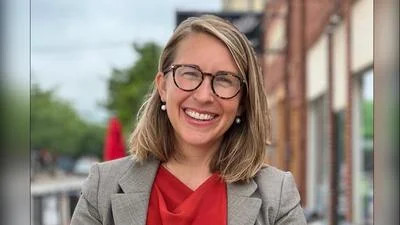City of Grand Rapids issued the following announcement on Jan. 21.
The Grand Rapids City Commission held its bimonthly meetings Tuesday and took action on a land acquisition strategy for a new fire station, the sale of City-owned property for a mixed-use development project and an amendment to the Parks and Recreation Strategic Master Plan. It also heard a presentation on the Equitable Economic Development and Mobility Strategic Plan and recognized the 75th anniversary of water fluoridation. Here’s a recap:
New fire station
The City Commission approved a land acquisition strategy for a new fire station along the South Division corridor. The strategy includes an option agreement for the eventual purchase of property at 1823 and 1815 Division Ave. S. not to exceed $880,000. The land acquisition would enhance public safety and provide for additional development opportunity.
“This aligns with our organization’s strategic priority of making sure all people feel safe and are safe at all times throughout our community,” Fire Chief John Lehman said. “The new fire station will help us continue to decrease response times in the southeast side of our city.”
The land currently is owned by nonprofit In the Image, which plans to relocate in the city.
Once completed, the newly built fire station would replace the one at 1734 Division Ave. S. The current fire station is in operation but is functionally obsolete. The Grand Rapids Fire Department’s south battalion chief moved to the current Division Avenue fire station a year ago to decrease response times in that area of the city.
The current fire station was built in 1926. It has several structural deficiencies, most notably the size and strength of the apparatus bay. Only certain pieces of fire equipment can fit inside the bay, which limits response models.
The station also limits the fire department in its commitment to being equitable and inclusive with residents and first-responders. The non-descript building has limited parking and its only access point is via a steep narrow walkway that leads to a stairway. For the firefighters housed there, shared restrooms, a large shared bunkroom and limited privacy make it challenging to house all firefighters together.
The Fire Department will work through the budget process to determine the construction timeline.
“We look forward to engaging the community in the exterior design elements of the new fire station, “ Lehman said. “We are committed to making sure it is a welcoming place that is representative of the diverse community we serve.”
Mixed-use development
The City Commission also approved an option agreement for the eventual sale and development of a portion of the City-owned property at 22 Ottawa Ave. NW. The portion – known as The Wedge – is part of property that includes the City’s Ottawa-Fulton parking ramp.
The proposed development provides an opportunity for the City to pilot strategies and develop protocols for implementation and on-going maintenance of programming to support affordable housing and the utilization of micro-local, women-owned and minority-owned business enterprise initiatives.
The one-year option agreement defines the terms, conditions and timeline for locally owned Wheeler Development Group to complete due diligence and negotiate an agreement with the City for the development of a mixed-use project at the property. The agreement follows the City’s request for a development partner for a mixed-use multi-story development on the 17,400-square-foot parcel.
The request required ground-floor retail space, five levels of parking that can be connected to the City’s existing ramp and additional development on floors above the parking. It included the following goals:
- Maximize density and height
- Consistency with the goals of GR Forward
- Project quality and timing
- Financial capacity and ability to complete a project within three years
- Developer track record for success with similar projects
- Necessity and likelihood of development incentives
- Inclusion of residential units and concepts for reserving a portion of units for affordable housing
- Commitment to prioritize, along with past performance of utilization of micro-local, women-owned and minority-owned contractors
- Value, including sale price
The development proposed by Wheeler Development Group is a 24-story, 280-foot-tall mixed-use building that features the following:
- Ground-floor retail totaling 5,215 square feet
- Five floors of parking totaling of 185 spaces
- Three floors of office space totaling 44,000 square feet
- Ten floors of residential apartments totaling 118 units – including up to 20 percent for households earning 80 percent or less of the area median income – and community space
- Five floors of residential condominiums totaling roughly 19 units
Equitable Economic Development and Mobility Strategic Plan
The City Commission heard a presentation on the final draft of the Equitable Economic Development and Mobility Strategic Plan. The five-year plan – created through a collaborative effort of the City’s Mobile GR and Economic Development staff and more than 100 community stakeholders – includes objectives and innovative targeted strategies for the two departments’ work related to the City’s overall strategic plan.
The strategies are intended to leverage City investments, resources and partnerships to ensure resources are deployed in a way that helps to eliminate barriers and create more equitable outcomes and access to opportunity while continuing to support strategies that have produced strong economic growth and enable expanding opportunities.
The plan is aligned with the City’s strategic plan and seeks to support economic competitiveness, which is dependent on more equitable participation in the economy. The plan also seeks to enhance citywide mobility options and increase safety and promote inclusive growth and access to City services.
The plan identifies 12 objectives and 40 strategies – including 11 priority near-term strategies to be implemented over the next 12 months – that build from the City’s strengths and address challenges to equitable economic development and mobility.
The Equitable Economic Development and Mobility Strategic Plan will lead to:
- Enhanced tools for the City to communicate, collaborate with partners and provide information about economic development and mobility practices and opportunities
- An equitable economic development scorecard to evaluate and award incentives
- New links between incentive programs and the hiring of minority-owned, women-owned and micro-local business enterprise contractors
- Better resourced corridor improvement authorities
- New resources for the City to attract and retain businesses
- A parking expansion decision tool
- Strategic planning for mobility programs and capital improvements
- A pilot transportation demand management incentive program
- Increased collaboration and integration between Economic Development and Mobile GR to support inclusive growth
The same is true for mobility, said Josh Naramore, the City’s Mobile GR and Parking Services manager.
“Significant strides have been made in recent years in mobility related to parking, transit, transportation demand management and safety. However, similar disparities exist when data is analyzed,” Naramore said. “Vulnerable and historically marginalized communities of color experience disproportionately high levels of impact whether related to accidents or access to safe, affordable and efficient transportation options.”
Economic development strategies will address the following objectives:
- Information – Help overcome the information and social capital gap and make the City a hub of information for accessing services and resources available to the business community
- Incentives – Ensure the City's incentive programs promote inclusive growth and create benefits throughout Grand Rapids and update the City's approach to deploying incentives to enhance access to opportunity for small businesses and historically marginalized communities
- Small business – Remove barriers to financial and social capital and use City resources and strategic partnerships to enhance access and opportunity for small businesses and property owners, particularly for minorities and those in neighborhoods of focus – 17 Census tracts that have concentrated poverty and unemployment
- Neighborhoods – Reduce geographic barriers to development and support Grand Rapids' neighborhoods and provide technical assistance and funding for real estate development in neighborhood business districts
- Economic growth – Ensure the long-term strength of Grand Rapids' economy and its attractiveness to both residents and businesses and continue to promote job creation and high quality of life in the city
- Alignment – Align planning and capital investments to support economic development and promote equitable outcomes
- Transportation demand management – Manage transportation demand by making programs, policies and incentives more effective
- Curb management – Establish curb management practices that promote City goals
- Capacity – Invest in staff and system capacity to meet the mobility needs of all Grand Rapids residents
- Asset management – Develop an asset management approach that supports the long-term health of the City’s mobility networks
- Communication – Establish comprehensive communications, engagement and education programs
- Strategic partnerships – Cultivate and capitalize upon strategic partnerships to achieve the City’s equitable mobility goals
Read the Equitable Economic Development and Mobility Strategic Plan’s executive summary HERE. More information about the plan is available HERE.
Parks and Recreation Strategic Master Plan
The City Commission approved an amendment to the 2017 Parks and Recreation Strategic Master Plan to include the Grand River corridor implementation plan and river trail design guidelines, also known as River for All. The approval followed a public hearing earlier in the month on the proposed amendment.
- The City Commission approved an amendment to the 2017 Parks and Recreation Strategic Master Plan to include the Grand River corridor implementation plan and river trail design guidelines, also known as River for All. The approval followed a public hearing earlier in the month on the proposed amendment. The river corridor plan – the result of robust community engagement – features three primary components. They arGrand River corridor design guidelines – Provide design guidelines for the future river trail and river edge improvements along the 7.5-mile river corridor to create a cohesive and accessible river trail system that serves the entire Grand Rapids communityGrand River corridor design guidelines – Provide design guidelines for the future river trail and river edge improvements along the 7.5-mile river corridor to create a cohesive and accessible river trail system that serves the entire Grand Rapids community
- Conceptual design for six opportunity sites on the border of the Grand River – Expands on the design guidelines to create conceptual design for six sites along the corridor: Leonard to Ann trail connection, Water Department storage yard site, Coldbrook decommissioned water treatment plant site, North Monroe redevelopment site, Grand Rapids Public Museum and Fish Ladder Park
- Strategic asset management plan – Examines how the future improvement recommendations outlined in the design Guidelines should be managed and maintained for their long-term success
The River for All plan symbolizes the significance of the Grand River to Grand Rapids, Kent County and West Michigan as a prominent feature that can enhance the quality of life for all through activation, beautification, restoration and connection. The river improvements and public spaces along the riverfront are expected to be amenities for all residents and visitors of Grand Rapids to enjoy. Bike routes, pedestrian trails and tributaries will provide connections to residents outside of the river corridor and into adjacent neighborhoods, providing a critical missing link for the region. The Grand River corridor implementation plan, river trail design guidelines and the effort to restore the rapids and enhance flood protection in the Grand River are all part of the vision to create a river for all.
The Parks and Recreation Advisory Board in November voted in support of including the River for All plan into the Parks and Recreation Strategic Master Plan, in addition to including the 14 neighborhood park master plans. The amended plan will be submitted to the Michigan Department of Natural Resources.
Water fluoridation anniversary
The City Commission also recognized the 75th anniversary of community water fluoridation. On Jan. 25, 1945, the City of Grand Rapids became the first U.S. city to add fluoride to its water to help prevent tooth decay. Tuesday’s celebration included a proclamation from Mayor Rosalynn Bliss. Read the proclamation HERE.
For a complete look at Tuesday’s City Commission meeting agendas, CLICK HERE.
Original source can be found here.

Source: City of Grand Rapids






 Alerts Sign-up
Alerts Sign-up